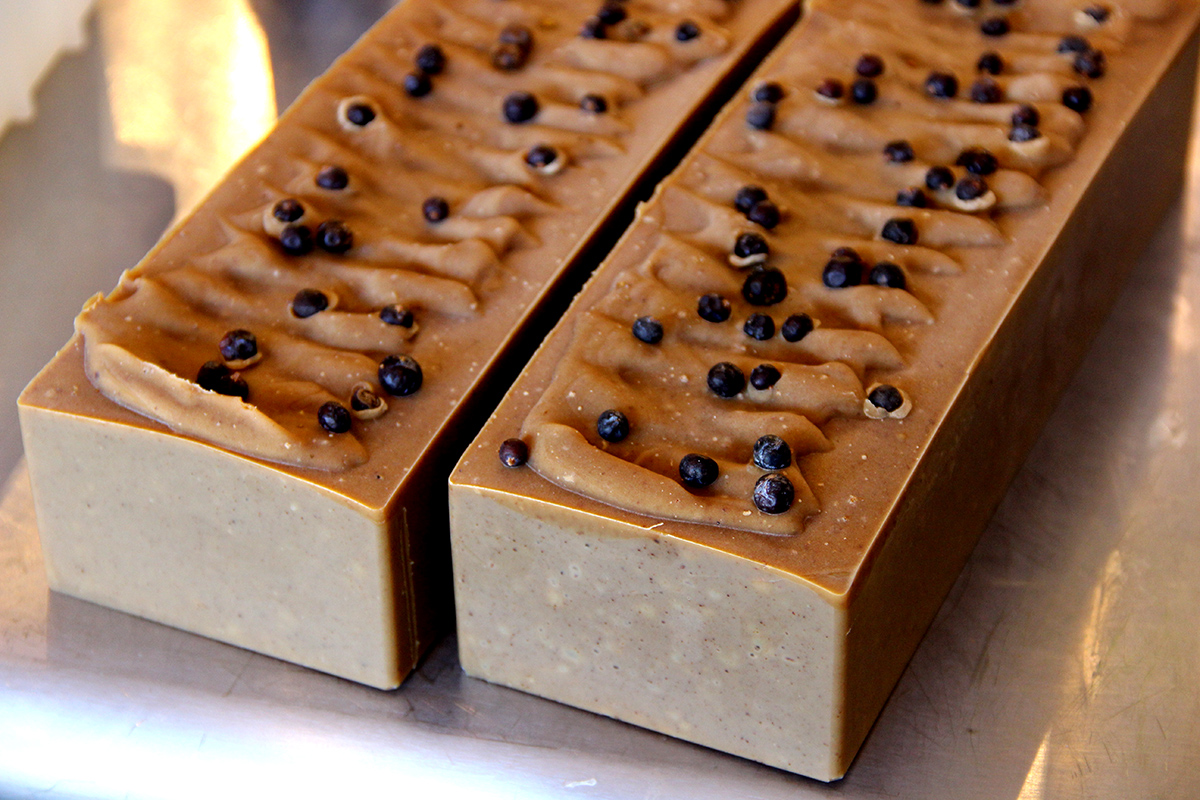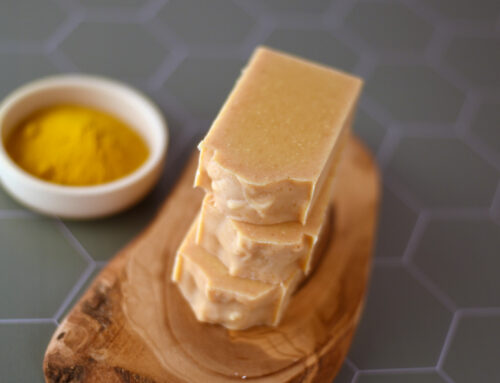This is a soap Benjamin and I made for Prairie Soap Company’s holiday lineup. He makes a soap called Sweet Earth which uses juniper berries in the lye water. He grinds the juniper berries up using a coffee grinder. Added to the lye water they soften, produce a bit of color and impart a bit of aroma, like dark chocolate, which can add quite a bit of complexity to your essential oil blend. This recipe is a bit of a variation of Sweet Earth; we’re calling it Juniper Berry.
If you want to grab all of Benjamin’s recipes from his soap company, he shared them in his eBook:
Cold Process Soap Recipes: 55 Tried-And-True Soap Recipes from a Successful Soap Company
Juniper Berry Soap Recipe
(fills two 8″ silicone soap molds)
Coconut oil – 540 grams (30%)
Shea butter – 180 grams (10%)
Olive oil – 540 grams (30%)
Castor oil – 180 grams (10%)
Avocado oil – 180 grams (10%)
Rice bran oil – 180 grams (10%)
Cocoa powder – 1 tablespoon
Lye – 252 grams
Water – 504 grams
Ground Juniper Berries – 2 tablespoons
Vanilla Oleoresin EO – 8 grams
Anise EO – 8 grams
Juniper Berry EO – 8 grams
Almond EO – 4 grams
Ylang Ylang EO – 4 grams
Patchouli EO – 4 grams
Sweet Orange EO – 16 grams
Let’s make soap! If you are new to soapmaking, be sure to download our free guide, How to Make Cold Process Soap! Gear up in your gloves and your safety glasses.
Step 1: Create a lye solution. Weigh the water and lye into two separate containers. Slowly pour the sodium hydroxide into the water while stirring. Stir until completely dissolved. Add 2 tablespoons of ground juniper berry. Adding the juniper berry to the lye water helps to soften it. I simply grind mine in a coffee grinder.
Step 2: Prepare the base oils. First, weigh any solid oils and butters into a container and melt. You can melt using the microwave or low heat on a burner. Next, weigh each liquid oil into the melted oils. The liquid oils will cool down the melted oils and leave you with a base oil mixture that is about at the correct temperature to make soap. It might still need to cool down a bit.
Step 3: Weigh your essential oil or fragrance oil into a glass or stainless steel container and add to your base oil.
Step 4: Prepare your mold. If you need to line your mold, line it.
Step 5: Check the temperatures. You should now have a container containing liquid base oils and a container containing lye solution. Take the temperatures using an infra-red temperature gun. Be sure to stir each mixture before taking the temp. You want your temperatures to be between 80-110° F.
Step 6: Once you have reached desired temperatures, pour the lye solution into the oil mixture and mix to medium trace.
Step 7: Pour into your molds! This recipe fits two 8″ – 10″ silicone loaf molds.
Step 8: I teased the top a bit for some texture and then added dried juniper berries on top for interest!
Step 9: Let your soap harden and saponify for at least 24 hours.
Step 10: Unmold and cut!
Cure your soap for 4-6 weeks.
This soap smells amazing! Earthy, festive and perfect for this time of year.
Happy Soaping!
Thanks for reading!












Such a lovely soap. I made earlier today and can’t wait for it to be done! Such a unique fragrance blend. Never worked with juniper berries before and was excited to try something new.
when do you add the cocoa powder?
what do you do with the second tablespoon of ground juniper berries? I want to make this soap but the instructions are very vague
Hi! You add both to the lye water. That was a mistype. Thanks!
What do you do with the second tablespoon of ground juniper berries?
hobbie lobby sells those soap molds in the United States
Thank you for the recipe and instructions.
I am late to this party, but very much enjoyed making this soap. I have a question about the naturally acidic juniper berries. When I pH test different mixtures of juniper berries in distilled water, I get a reading of 5. Rosehips and hibiscus are also acidic, and I did have very odd soap results once when I added rosehip powder.
Anyway, do the juniper berries in lye solution cause enough of a change that we need to compensate? At first I thought, “Well, I will just end up with a greater superfat,” but then I wondered about the results in a larger batch of soap.
Because I know that you and Benjamin work with many natural additives, I wondered whether you adjust your recipes for pH, or whether it’s so small that you haven’t encountered a problem.
Thank you very much! (I also want to say that your newsletter is the best format ever, and the one I always read. 🙂
Hy! Thanks ..
I believe ours comes from Liberty Naturals. It can be a bit pricy but it really adds depth and sweetness to blends. You could try it without and it would still be a nice smell. -Amanda
Hi Amanda, this looks amazing! I’ve just started making soap and this one is on the “to make” list for when I have a few more basic batches under my belt.
Where do you buy your bitter almond essential oil from? The supplier that I normally purchase essential oils from has it, but it seems to be quite pricey.
Thanks for your time.
Amanda, Merry Christmas!
Best wishes from Moscow))
Thank you! i love your site
This sounds lovely! Something I’ve never tried.
I love this Amanda 🙂 will have to make it 🙂
HI
I’m trying to click through to see the T shirts but cant get to the page, is there any other link to them?
Cheers
They are 8″ silicone molds from Wholesalesuppliesplus.com 🙂
http://www.wholesalesuppliesplus.com/products/regular-loaf-silicone-mold.aspx
I LOVE these molds! So easy and no lining!
Very nice soap but would love to find out where to purchase one of the molds you have used for this soap. I’ve looked just about everywhere I can think to but so far, not much luck. Any help would be appreciated.
Again, gorgeous soap !
Jenn